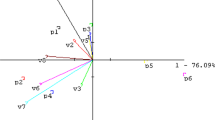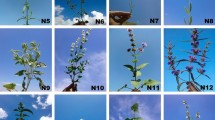Abstract
EXAMINATION of the leaves of a series of grasses in the usual way1, which involves hydrolysing the leaves in 2 normal hydrochloric acid and extracting the hydrolysate with isoamyl alcohol, showed in four of them the presence of a component giving rise to a scarlet-coloured anthocyanidin having an Rf of 0.62 in Forestal solvent (acetic acid : concentrated hydrochloric acid : water, 30 : 3 : 10 by volume). The extract, diluted with methanol, had λmax between, 496 and 502 nm, indicating its probable identity with luteolinidin (Rf 0.62 in Forestal, λmax in, methanol 496 nm (ref. 2)). It thus seems that the four grasses contain a leucoluteolinidin. It is unlikely that such a compound could have a flavan-3,4-diol structure, but the flavan-4-ol (4,5,7,3′,4′-pentahydroxyflavan) produced by reduction of eriodictyol with sodium borohydride (unpublished results of T. Swain) and a methanolic extract of the grasses behaved identically both when boiled with 2 normal hydrochloric acid (yielding luteolinidin) and when treated with cold concentrated hydrochloric acid. In the latter case a blue colour was produced with λmax 550 nm, the product responsible being, perhaps, the carbonium ion of the ring-opened form of the flavan3. On standing, or after dilution and heating, this was partially converted into luteolinidin. It should be noted that other flavan-4-ols show similar behaviour3, but flavan-3,4-diols (for example, leucocyanidin), although giving an intermediate blue–purple component when heated in 2 normal hydrochloric acid, do not give such a colour with cold concentrated acid.
This is a preview of subscription content, access via your institution
Access options
Subscribe to this journal
Receive 51 print issues and online access
$199.00 per year
only $3.90 per issue
Buy this article
- Purchase on Springer Link
- Instant access to full article PDF
Prices may be subject to local taxes which are calculated during checkout
Similar content being viewed by others
References
Bate-Smith, E. C., J. Linn. Soc. (Bot.), 58, 95 (1963).
Harborne, J. B., Phytochem., 5, 589 (1966).
Geissman, T. A., and Clinton, R. O., J. Amer. Chem. Soc., 68, 700 (1946).
Geissman, T. A., and Dittmar, H. F. K., Phytochem., 4, 399 (1965).
Creasy, L. L., and Swain, T., Nature, 208, 109 (1965).
Bate-Smith, E. C., J. Linn. Soc. (Bot.) (in the press).
Stafford, H. A., Plant Physiol., 40, 130 (1965).
Blessin, G. N., Van Etten, C. H., and Dimbler, R. J., Cereal Chem., 40, 241 (1963).
Yasumatsu, K., Nakayama, T. O. M., and Chichester, C. O., J. Food Sci., 30, 663 (1965).
Author information
Authors and Affiliations
Rights and permissions
About this article
Cite this article
BATE-SMITH, E., SWAIN, T. New Leuco-anthocyanins in Grasses. Nature 213, 1033–1034 (1967). https://doi.org/10.1038/2131033a0
Issue Date:
DOI: https://doi.org/10.1038/2131033a0
Comments
By submitting a comment you agree to abide by our Terms and Community Guidelines. If you find something abusive or that does not comply with our terms or guidelines please flag it as inappropriate.



